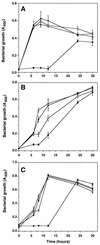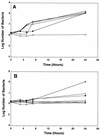Isolation of nitrofurantoin-resistant mutants of nitroreductase-producing Clostridium sp. strains from the human intestinal tract
- PMID: 9593138
- PMCID: PMC105756
- DOI: 10.1128/AAC.42.5.1121
Isolation of nitrofurantoin-resistant mutants of nitroreductase-producing Clostridium sp. strains from the human intestinal tract
Abstract
Five spontaneous nitrofurantoin-resistant mutants (one each of Clostridium leptum, Clostridium paraputrificum, two other Clostridium spp. strains from the human intestinal microflora, and Clostridium perfringens ATCC 3626) were selected by growth on a nitrofurantoin-containing medium. All of the Clostridium wild-type and mutant strains produced nitroreductase, as was shown by the conversion of 4-nitrobenzoic acid to 4-aminobenzoic acid. High-performance liquid chromatography (HPLC) analysis of the mutants during incubation with 50 microg of nitrofurantoin per ml showed the gradual disappearance of the nitrofurantoin peak. The nitrofurantoin peak also disappeared when cell-free supernatants instead of cultures of each of the resistant and wild-type bacteria were used, but it persisted if the cell-free supernatants had been inactivated by heat. At least two of the mutants converted nitrofurantoin to metabolites without antibacterial activity, as was shown by a bioassay with a nitrofurantoin-susceptible Bacillus sp. strain. Nitrofurantoin at a high concentration (50 microg/ml) continued to exert some toxicity, even on the resistant strains, as was evident from the longer lag phases. This study indicates that Clostridium strains can develop resistance to nitrofurantoin while retaining the ability to produce nitroreductase; the mutants metabolized nitrofurantoin to compounds without antibacterial activity.
Figures



 , C. perfringens
3626NF; ▤, Clostridium sp. strain
NR8NF; ▨, C. leptum NP15NF; □,
Clostridium sp. strain NR9NF; ▩, BHI medium.
, C. perfringens
3626NF; ▤, Clostridium sp. strain
NR8NF; ▨, C. leptum NP15NF; □,
Clostridium sp. strain NR9NF; ▩, BHI medium.
Similar articles
-
Q48K mutation in the type IB nitroreductase NrmA is responsible for nitrofurantoin resistance in Enterococcus faecium.Int J Antimicrob Agents. 2024 Sep;64(3):107277. doi: 10.1016/j.ijantimicag.2024.107277. Epub 2024 Jul 19. Int J Antimicrob Agents. 2024. PMID: 39032672
-
Inhibition of nitrofurantoin reduction by menthol leads to enhanced antimicrobial activity.J Chemother. 2003 Oct;15(5):449-53. doi: 10.1179/joc.2003.15.5.449. J Chemother. 2003. PMID: 14598936
-
Nitrofurantoin resistance mechanism and fitness cost in Escherichia coli.J Antimicrob Chemother. 2008 Sep;62(3):495-503. doi: 10.1093/jac/dkn222. Epub 2008 Jun 10. J Antimicrob Chemother. 2008. PMID: 18544599
-
Optimizing dosing of nitrofurantoin from a PK/PD point of view: What do we need to know?Drug Resist Updat. 2019 Mar;43:1-9. doi: 10.1016/j.drup.2019.03.001. Epub 2019 Mar 20. Drug Resist Updat. 2019. PMID: 30947111 Review.
-
An update on the role of nitrofurans in the management of urinary tract infections.Drugs. 2001;61(3):353-64. doi: 10.2165/00003495-200161030-00004. Drugs. 2001. PMID: 11293646 Review.
Cited by
-
Alterations in chromosomal genes nfsA, nfsB, and ribE are associated with nitrofurantoin resistance in Escherichia coli from the United Kingdom.Microb Genom. 2021 Dec;7(12):000702. doi: 10.1099/mgen.0.000702. Microb Genom. 2021. PMID: 34860151 Free PMC article.
-
Unlocking Nitrofurantoin: Understanding Molecular Mechanisms of Action and Resistance in Enterobacterales.Med Princ Pract. 2025;34(2):121-137. doi: 10.1159/000542330. Epub 2024 Oct 29. Med Princ Pract. 2025. PMID: 39471786 Free PMC article. Review.
-
An in vitro deletion in ribE encoding lumazine synthase contributes to nitrofurantoin resistance in Escherichia coli.Antimicrob Agents Chemother. 2014 Dec;58(12):7225-33. doi: 10.1128/AAC.03952-14. Epub 2014 Sep 22. Antimicrob Agents Chemother. 2014. PMID: 25246406 Free PMC article.
-
Alterations in DNA gyrase and topoisomerase IV in resistant mutants of Clostridium perfringens found after in vitro treatment with fluoroquinolones.Antimicrob Agents Chemother. 2005 Feb;49(2):488-92. doi: 10.1128/AAC.49.2.488-492.2005. Antimicrob Agents Chemother. 2005. PMID: 15673722 Free PMC article.
-
Counteraction of antibiotic production and degradation stabilizes microbial communities.Nature. 2015 May 28;521(7553):516-9. doi: 10.1038/nature14485. Nature. 2015. PMID: 25992546 Free PMC article.
References
-
- Asnin R E. The reduction of furacin by cell free extracts of furacin resistant and parent susceptible strains of E. coli. Arch Biochem Biophys. 1957;66:208–216. - PubMed
-
- Aufrere M B, Hoener B A, Vore M. Reductive metabolism of nitrofurantoin in the rat. Drug Metab Dispos. 1978;6:403–411. - PubMed
-
- Beunders, A. J. 1994. Development of antibacterial resistance: the Dutch experience. J. Antimicrob. Chemother. 33(Suppl. A):17–22. - PubMed
MeSH terms
Substances
LinkOut - more resources
Full Text Sources
Molecular Biology Databases
Miscellaneous

